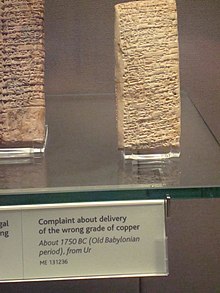Ea-nasir
Ea-nasir ( fl. Middle of the 18th century BC ) was a Babylonian wholesaler who probably lived in Ur and who became known through preserved clay tablets with messages from his customers, including letters of complaint. In particular, the complaint by a certain Nanni, to whom Ea-nasir wanted to sell inferior copper , has become an internet phenomenon as the "oldest letter of complaint in the world" and is in the Guinness Book of the Records have been recorded.
Life and business
In his publication from 1960, Wilhelmus F. Leemans describes Ea-nasir as a major wholesaler who bought copper in Dilmun and sold it to various dealers on the waterway to Ur, based on the clay tablets that were found in Ea-nasir's probable residence in Ur sent. Ea-nasir allegedly stayed in Dilmun for a long time, where he received orders and complaints from Ur, which he carried with him on his return. However, Ea-nasir's main business, according to Leemans, was likely to be the direct import of copper for the Palace of Ur. His greater interest in this activity for the palace is cited as a possible explanation for the fact that he paid less attention to his private business relationships. Ea-nasir's customers also included the copper dealer Nanni. In addition to copper bars, Ea-nasir traded products made of copper and occasionally textiles and food or, according to Michael Rice, "anything in which he could see an opportunity for profit."
Ea-nasir's credit appears to have deteriorated over time. In addition to the increase in "warning letters" to Ea-nasir in the course of his career, other results of the excavations of Leonard Woolley indicate that Ea-nasir was recently forced to live in more modest circumstances. A part of his house in Ur was apparently separated while Ea-nasir was still alive and united with the house of a neighbor.
Michael Rice writes in The Archeology of the Arabian Gulf that the letters to Ea-nasir "shine mischievously" amid a mass of tiresome, albeit historically significant, tablets of business correspondence, and the tones of hurt surprise and censure found in many of them , would be familiar to many today's debtors. The Akkadian clay tablets that have been preserved contain, among other things, complaints that a middleman (usually a certain nigga-nanna) has not received copper that has already been paid for. In particular, people called Arbituram, Appa, Ilsu-ellatsu and Ili-idinnam complained to Ea-nasir. However, the best known is the angry letter from Nanni, which was written around 1750 BC. BC complained that Ea-nasir had offered his messenger inferior copper bars. Nanni's messengers would have had to return empty-handed through enemy territory several times. Among other things, Nanni writes: “Who do you think you are to treat someone like me with such contempt? [...] Is there any other trader who does business with Dilmun who has treated me this way? Only you meet my messenger with contempt! […] Take note that I will no longer accept copper from you that is not of good quality. I will from now on select the bars one by one in my own yard and I will exercise my right to refuse you because you treated me with contempt. ”The clay tablet with Nanni's complaint was found by Leonard Woolley in Ur and in 1953 by the British Museum acquired.
Internet phenomenon
Since 2015, Nanni's complaint has been spreading increasingly on Internet platforms. The increased attention was due to the Reddit post by a user under the name tbc34 , which was shared and commented on many times. After several articles on the topic had already appeared, for example on ABC Science , the letter of complaint was again popularized on Reddit in 2018. This has even led to the creation of fan fiction with Ea-nasir and Nanni as the characters.
In the meantime, the Guinness Book of Records has added Nanni's letter to its database as the Oldest written customer complaint .
literature
- Wilhelmus F. Leemans: Foreign trade in the old Babylonian period as revealed by texts from Southern Mesopotamia. Brill, Leiden 1960.
- Adolf Leo Oppenheim: Letters From Mesopotamia. Official, Business, and Private Letters on Clay Tablets from Two Millennia. The University of Chicago Press, Chicago / London 1967.
- Michael Rice: The Archeology of the Arabian Gulf. c. 5000-323 BC. Routledge, London / New York 1994. ISBN 978-0-415-03268-1 (Paperback 2011: ISBN 978-0-415-51319-7 ). In it on Ea-nasir especially pp. 276–280.
Individual evidence
- ^ A b Wilhelmus F. Leemans: Foreign trade in the old Babylonian period as revealed by texts from Southern Mesopotamia . Brill, Leiden 1960, p. 53 .
- ^ A b Wilhelmus F. Leemans: Foreign trade in the old Babylonian period as revealed by texts from Southern Mesopotamia . Brill, Leiden 1960, p. 54 .
- ^ Wilhelmus F. Leemans: Foreign trade in the old Babylonian period as revealed by texts from Southern Mesopotamia . Brill, Leiden 1960, p. 52 .
- ↑ a b Kristina Killgrove: Meet The Worst Businessman Of The 18th Century BC ( English ) In: Forbes . May 11, 2018. Retrieved August 14, 2020.
- ^ A b c Michael Rice: The Archeology of the Arabian Gulf . Routledge, London / New York 2011, ISBN 978-0-415-51319-7 , pp. 276 .
- ↑ Michael Rice: The Archeology of the Arabian Gulf . Routledge, London / New York 2011, ISBN 978-0-415-51319-7 , pp. 278 .
- ^ Based on the English translation by Adolf Leo Oppenheim in: Adolf Leo Oppenheim: Letters From Mesopotamia. Official, Business, and Private Letters on Clay Tablets from Two Millennia . The University of Chicago Press, Chicago / London 1967, p. 82-83 ( online ).
- ↑ tablet ( English ) British Museum. Retrieved August 14, 2020.
- ↑ Nadine Kalinauskas: At the British Museum, oldest recorded customer-service complaint on display ( English ) In: Yahoo! News . March 10, 2015. Accessed August 14, 2020.
- ^ Karl S. Kruszelnicki: The oldest known complaint letter . In: ABC Science . ABC. S. English. March 24, 2015. Accessed August 14, 2020.
- ↑ Kabir Chibber: The world's first customer complaint is almost 4,000 years old ( English ) In: Quartz . August 21, 2018. Accessed August 14, 2020.
- ↑ 11 Works in Ea-Nasir (Mesopotamian) ( English ) In: Archive of Our Own . Retrieved August 14, 2020.
- ↑ Oldest written customer complaint ( English ) Guinnes World Records. Retrieved August 14, 2020.
| personal data | |
|---|---|
| SURNAME | Ea-nasir |
| BRIEF DESCRIPTION | Babylonian wholesaler |
| DATE OF BIRTH | 19th century BC BC or 18th century BC Chr. |
| DATE OF DEATH | 18th century BC BC or 17th century BC Chr. |

